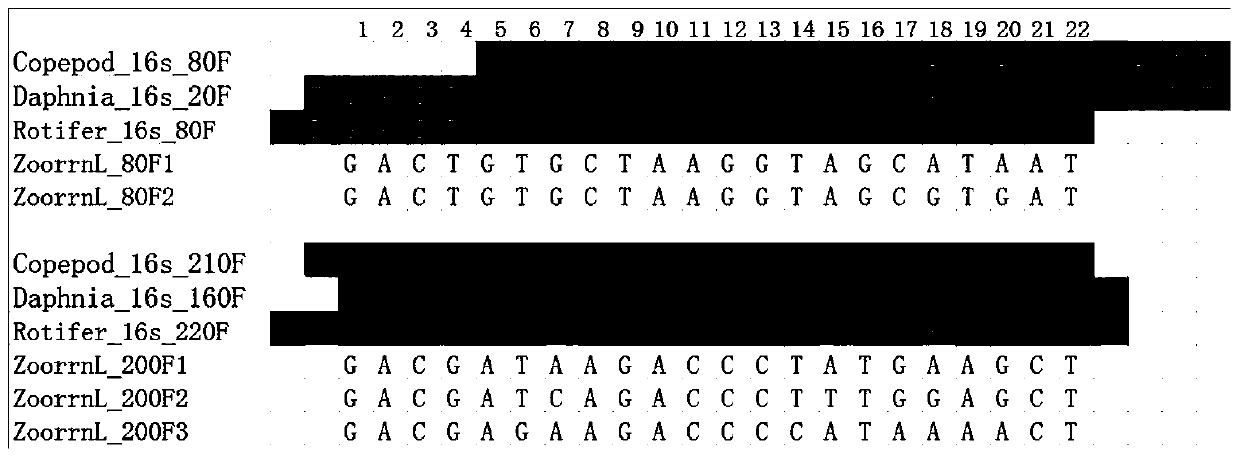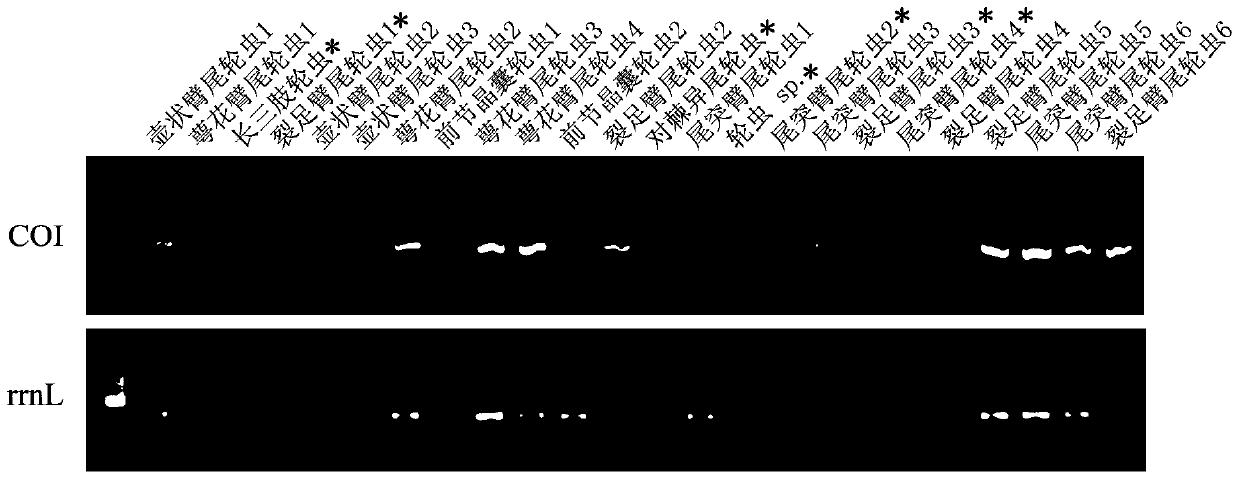Zooplankton rrnl gene amplification primer and its screening method and application and application method
A technology for zooplankton and gene amplification, applied in biochemical equipment and methods, special data processing applications, microbial measurement/inspection, etc., can solve the harsh conditions of PCR reaction, poor amplification ability of crustacean groups, difficult sequencing, etc. problems, to achieve the effect of improving the success rate of PCR, mild conditions, and reducing non-specific amplification
- Summary
- Abstract
- Description
- Claims
- Application Information
AI Technical Summary
Problems solved by technology
Method used
Image
Examples
Embodiment 1
[0043] (1) Sequence processing of metazoan plankton rrnL gene
[0044] Download all zooplankton rrnL gene sequences from NCBI database and BLOD database, a total of 1558 sequences, including 176 rotifer sequences, 642 copepod sequences, and 740 cladoceran sequences, and remove the duplications among them by bioinformatics software Sequences, so that there are no more than 3 sequences for each species. After screening, 44 rotifer sequences, 132 copepod sequences, and 109 cladocera sequences were finally obtained. Use the software mafft-win to perform sequence comparison on the above sequences respectively, take the shortest sequence as the standard, remove the parts of other sequences that are not aligned at both ends to make all sequences equal in length, and then delete the occurrence frequency of each site that is less than 10%. Base, and then output the conserved sequences of rotifers, cladocerans, and copepods respectively, and put together the conserved sequences of rotif...
Embodiment 2
[0053] Zooplankton samples were collected in Zhushan Bay (120.036°E, 31.373°N) and Miaogang (120.461°E, 31.002°N) in Taihu Lake, Jiangsu Province. The collected samples were stored in 90% alcohol on site, and then brought to the experiment The laboratory carried out species identification and separation, and a total of 7 species of rotifers were collected (Brachionus calyxae, Brachionus cucurbitus, Trilimidae longus, Brachioperus schizopoda, Cysticus anteriore, Caucus Brachionus rotifers and Rotifers sp.) 4 species of Cladocera (Daphnia fuzzy, Diaphragm pellucidum, Daphnia diaphyllum and Daphnia chinensis) and 5 species of copepods (Daphnia globosa, DNA of a single zooplankton was extracted from Daphnia spp., Daphnia dextritus, Daphnia sp. and Daphnia mammoth sp.). The extracted zooplankton DNA was amplified by PCR with rrnL primers and COI primers respectively. When amplifying with rrnL primers, select the combination of ZoorrnL_80F and ZoorrnL_400R primers with the longest a...
Embodiment 3
[0055] Filter 30L of lake water with a zooplankton net (160μm pore size), concentrate the lake water to 50mL and then filter it with a filter membrane with a pore size of 50μm to remove water, according to The E.Z.N.A. Water DNA Kit (OMEGA, CHINA) kit standard operation was used to extract filter membrane DNA, and use rrnL primers and reagents in Example 2 to perform PCR amplification on filter membrane DNA. The PCR amplification product was recovered by tapping the gel with the MinEluteGel Extraction Kit (Qiagen, USA), and was recovered by Qubit TM dsDNA HS Assay Kits were used for quantification, and the purified PCR product was analyzed for fragment size using Bioanalyser 2100 (Agilent Technologies, USA). The analysis results were as follows: Figure 5 shown. It can be seen from the figure that the amplification of environmental DNA with primers combined with ZoorrnL_80F and ZoorrnL_400R will have different fragment sizes, and the size distribution is between 321bp and 4...
PUM
 Login to View More
Login to View More Abstract
Description
Claims
Application Information
 Login to View More
Login to View More - R&D
- Intellectual Property
- Life Sciences
- Materials
- Tech Scout
- Unparalleled Data Quality
- Higher Quality Content
- 60% Fewer Hallucinations
Browse by: Latest US Patents, China's latest patents, Technical Efficacy Thesaurus, Application Domain, Technology Topic, Popular Technical Reports.
© 2025 PatSnap. All rights reserved.Legal|Privacy policy|Modern Slavery Act Transparency Statement|Sitemap|About US| Contact US: help@patsnap.com



